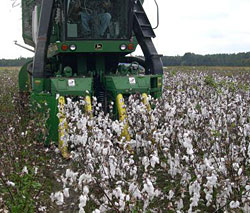Wood with altered properties and cheaper ethanol through more efficient production are two possibilities as a result of a find by a biologist at Washington University in St. Louis.
Erik Nielsen, Ph.D., Washington University adjunct professor of biology in Arts & Sciences, has made a discovery published in a recent edition of The Journal of Cell Biology that sheds new light on how some types of complex sugars in plants are directed to the construction of cell walls.

“In plants, light energy is harvested to produce sugars, and some of these are processed into complex polymers for specific uses. In our latest research, my team identified a distribution pathway for some of the complex sugars that are used in the construction of cell walls,” Nielsen explained. “This should help us understand how some of these building blocks of cell walls are delivered and how these building blocks are put together.”
Nielsen’s research is the first to identity some of the membrane trafficking steps in the deposition of cell wall components in an area that has been lightly researched. His study is important because cotton, wood and other plant fibers that are vital to everyday life rely on the plant cell wall, which gives wood the strength needed for construction and furniture, among other uses, and cotton fibers the elasticity for use in cloth. This research may lead to crops with stalks that can be used to produce biofuels more efficiently and would result in less waste following harvest.
Nielsen said that the novel scientific observation in the paper is the characterization of a membrane trafficking compartment believed to be involved in polar secretion of cell wall components in plants.
Delivering cargo
“In the paper we describe the identification of a cellular component that is essential for the proper targeting/delivery of secretory cargo to the tips of growing root hair cells,” Nielsen explained. “Root hair cells are a specific type of epidermal cell in roots that we been using to monitor secretion pathways in plants. We use root hair cells because during their development they undergo a highly polarized expansion, in which deposition of new cell wall components is restricted to the extreme tip of the growing root hair.”
In earlier work, Nielsen and his collaborators characterized a membrane compartment that became polarly localized to the tips of growing root hair cells. They used a marker that is a small regulatory GTPase, called RabA4b. GTPases bind and hydrolyze GTP (guanosine triphosphate). These regulatory GTPases are members of gene families in eukaryotes, and individual members specifically localize to various subcellular compartments and control membrane trafficking steps associated with them. In this work, the Nielsen team showed that RabA4b recruits a lipid kinase, PI-4Kb1, to the tip localized compartment and somehow PI-4Kb1 function is necessary for proper delivery of new cell wall components in these root hair cells.
The biofuel link
Currently ethanol production can be generated either by fermentation of starch from plant seeds, or cellulose — and other polysaccharides — from plant cell walls. Today, starch fermentation is the preferred method because it is easier, but it is also expensive because starch has other uses — such as for food, for example. Cellulose fermentation methods currently are not as efficient because the sugars in the cell wall are harder to release for fermentation into ethanol. Also complicating this is that, while cellulose can be released, often other cell wall components actually interfere with the fermentation process.
“If we could modify the content of the plant cell wall we may be able to produce plants whose cellulose and other cell wall polysaccharides are more readily available for fermentation,” Nielsen explained. “The other advantage if we could figure out how to make cellulosic ethanol fermentation work better is that these cell wall sources — such as corn husks and stalks — are not really used for much else at present. ”
Nielsen said that there are challenges in altering plant cell walls to make cellulose-based ethanol fermentation more efficient.
“Right now a real problem is that we really don’t know much about how plant cell walls are put together. While cellulose, the main load-bearing polysaccharide in plant cell walls, is synthesized at the plasma membrane, most of the other cell wall polysaccharides and cell wall proteins are synthesized and modified in the plant Golgi complex. These then have to somehow be delivered by membrane trafficking pathways to the correct places at the right times in order for normal plant cell growth and development to occur.”
Even the cellulose synthases that make cellulose have to be sorted and delivered properly using membrane trafficking pathways.
“Presently, we really have no idea how all this sorting and packaging of cell wall components is accomplished,” he said. “So what we’ve done with this research is to finally begin to characterize some of the compartments and membrane trafficking pathways that are involved in cell wall deposition.”